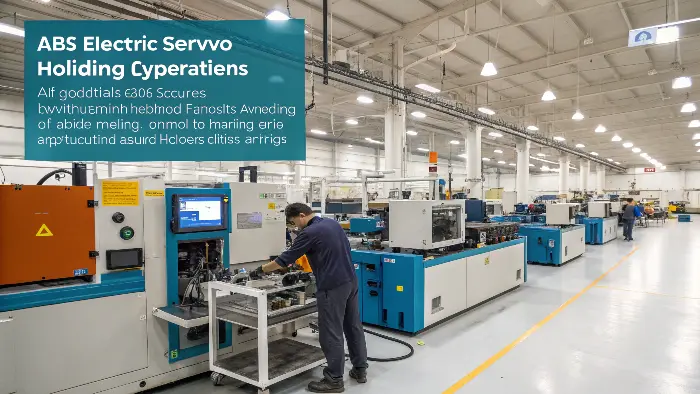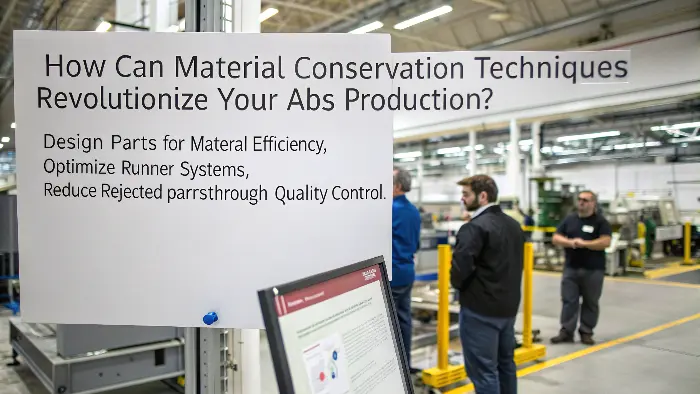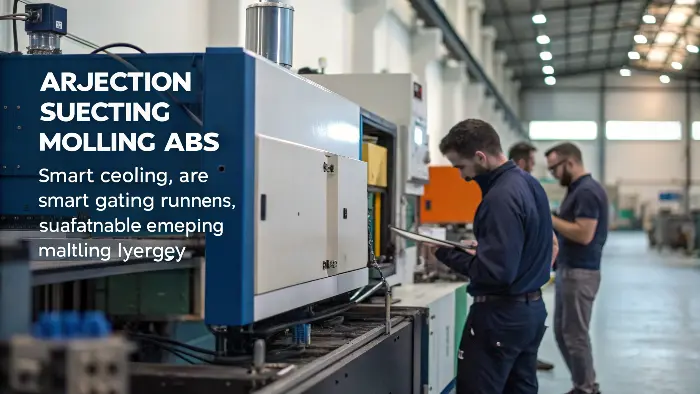Struggling with sustainable ABS molding? Rising costs and environmental pressures are real. Discover key strategies for greener, more cost-effective production right here.
Absolutely! Sustainable ABS injection molding is very achievable. It hinges on solid recycling programs, making your machines energy-efficient, and using smart ways to save material all through your production line. It’s about working smarter, not just harder.
So, you’re looking to make your ABS molding more sustainable. It’s a big topic, and frankly, it can feel a bit overwhelming at first. I get it. But trust me, breaking it down makes it manageable, and the benefits are totally worth it. I’ve seen firsthand in my years in this industry, from my early days on the factory floor to running CKMOLD, how small, smart changes can add up to big savings and a much better reputation for a business like yours, Michael. It’s not just about feeling good; it’s about good business. Let’s dive into how we can actually make this happen, piece by piece, so you can see real results.
How Can We Maximize ABS Recycling in Injection Molding?
Worried about ABS waste piling up in your facility? It’s not just bad for the planet; it’s literally wasted money that could be back in your pocket. Learn how to effectively recycle ABS and turn that waste into a valuable resource.
You can maximize ABS recycling by setting up efficient in-house regrinding for your production scrap, like runners and sprues. Also, consider partnering with specialized recyclers for post-consumer or more contaminated ABS waste. Proper sorting, cleaning, and drying of the regrind are absolutely key to maintaining quality.
Diving deeper into ABS recycling, it’s something I’ve spent a lot of time on. It’s not always straightforward, but the payoff is there. Many folks I talk to, especially business owners like Michael, are keen to reduce waste but worry about the quality of parts made with recycled content. And that’s a fair concern.
Challenges We Face with ABS Recycling
One of the main hurdles with ABS is degradation. Every time you melt and reprocess plastic, its properties can change a bit – think slightly lower impact strength or a shift in color. Contamination is another big one. If your scrap gets mixed with other plastics or dirt, it’s much harder to recycle effectively. And, of course, there’s the logistics: collecting, sorting, grinding, and then storing the regrind properly. It takes a system. I remember one client who was just tossing all their scrap into one bin – what a headache that became to sort later! We helped them set up a simple color-coded system at each machine, and it made a world of difference.
Smart Strategies for Effective ABS Recycling
The first step is to minimize scrap in the first place – we’ll talk more about that later. For the scrap you do generate, especially clean, in-house stuff like runners and sprues from a single material batch, regrinding it and blending it back with virgin material (at a carefully controlled ratio!) is often the best bet. You need good grinders that produce consistent particle sizes. And drying – ABS loves moisture, so dried regrind is crucial for part quality. For post-consumer ABS or heavily contaminated stuff, partnering with a reputable recycling company that has advanced sorting and cleaning tech is usually the way to go. They can often handle what you can’t.
In-House vs. Outsourcing Your Recycling: What’s Best?
| For many small to medium-sized businesses, handling clean, internal scrap in-house makes sense. You control the quality, and it’s often cheaper. But, setting up a full-blown recycling plant for diverse or dirty plastics? That’s a big investment. Outsourcing to specialists can be more cost-effective and environmentally sound for that kind of waste. It’s about finding the right balance for your specific operation. Here’s a quick look at how virgin and recycled ABS often compare: |
Property | Virgin ABS | Recycled ABS (Good Quality) | Notes |
|---|---|---|---|---|
| Impact Strength | High | Slightly Reduced to High | Depends heavily on contamination & number of heat cycles | |
| Tensile Strength | Good | Good | Generally holds up well if processed correctly | |
| Color Consistency | Excellent | Can vary, may need sorting | Darker colors are easier to manage with regrind | |
| Cost | Higher | Lower | Significant savings potential, especially with in-house regrind | |
| Processing | Consistent | May need slight adjustments | Monitor melt flow; thorough drying is essential! |
The key takeaway for recycling is that it’s totally doable and beneficial. It just requires attention to detail and a good system.
What Are the Best Ways to Boost Energy Efficiency in ABS Molding Operations?
Are high energy bills eating into your profits, Michael? I know that pain. Old machines and inefficient processes often guzzle power like there’s no tomorrow. Discover practical ways to cut energy use in your ABS molding operations.
Boost energy efficiency significantly by upgrading to all-electric or modern servo-hydraulic molding machines. Also, make sure to insulate heater bands, optimize your cycle times carefully, and regularly maintain all your equipment. These steps directly cut power consumption and improve your bottom line.

Energy efficiency – now this is a topic close to my heart! When I started my own factory, those energy bills were a shocker. It forced me to learn fast where the energy was going and how to stop the bleeding. For any manufacturing business, especially in plastics, energy is a huge operational cost. Cutting it down isn’t just green; it’s smart money.
Pinpointing Where Your Energy is Going
The biggest culprits in an injection molding setup are usually the machine drive (hydraulics or motors), barrel heaters, and then auxiliary equipment like dryers, chillers, and grinders. It’s amazing how much energy can be wasted by an old, inefficient hydraulic pump running constantly, or uninsulated heater bands radiating heat into the factory instead of into the plastic. I always tell people, "You can’t manage what you don’t measure." So, doing an energy audit, even a simple one, can be eye-opening. Sometimes, just walking the floor and feeling for hot spots can tell you a lot!
Upgrading Machinery: A Game Changer for Energy Savings
This is often the biggest leap forward. Modern all-electric injection molding machines can use 50-70% less energy than older hydraulic ones because they only use power when they’re actually moving. Servo-hydraulic machines are a good middle ground, offering significant savings over traditional hydraulics. I know new machines are a big investment, Michael, but the payback period from energy savings alone can be surprisingly short, especially with rising energy costs. Plus, you often get better precision and faster cycles – bonus!
Small Tweaks, Big Energy Wins in Process Optimization
| Beyond big machinery upgrades, there’s so much you can do. Insulating heater barrels is a no-brainer; the payback is often just a few months. Optimizing cycle times – even shaving off a second or two where possible without compromising quality – adds up over thousands of cycles. Ensuring molds are well-maintained with efficient cooling also reduces cooling time, which is a big part of the cycle. And don’t forget simple things like fixing compressed air leaks! Air is expensive. Here’s a look at some common energy-saving hotspots: |
Area | Problem | Solution | Potential Savings |
|---|---|---|---|---|
| Injection Machine | Old hydraulic systems, oversized machines | Switch to servo-hydraulic/all-electric, right-size machines | 20-70% | |
| Barrel Heaters | Poor insulation, inefficient control | Barrel insulation blankets, PID temperature controllers | 10-40% | |
| Mold Temperature | Inefficient heating/cooling systems | Optimized cooling channels, insulated molds, efficient chillers | 5-20% | |
| Auxiliary Equipment | Dryers, chillers, grinders running constantly | Energy-efficient models, variable speed drives, proper sizing | 10-50% | |
| Lighting & HVAC | Old fixtures, poor building insulation | LED lighting, smart thermostats, building insulation | 5-30% (overall) |
For a business owner like Michael, focusing on these areas can dramatically reduce operational costs and improve overall plant efficiency. It’s a continuous improvement journey, but the rewards are substantial.
How Can Material Conservation Techniques Revolutionize Your ABS Production?
Tired of seeing valuable ABS material end up as scrap or in parts that are heavier than they need to be? Waste isn’t just an environmental issue; it’s a direct hit to your bottom line, Michael. Let’s find ways to use less and save more.
Revolutionize material use by designing parts for material efficiency from the outset. Optimize runner systems—hot runners are fantastic for this—and drastically reduce rejected parts through robust quality control and highly stable processes. Every single gram of ABS saved counts towards profit.

Material conservation is a big one. I mean, the raw material – ABS resin in this case – is often the single largest cost component in a molded part. So, using less of it, or wasting less of it, goes straight to your profit margin. It’s as simple as that. Plus, customers are increasingly asking for lighter parts and less waste, so it’s a market driver too.
Designing Smarter: Less Material, Same Strength
This often starts right at the design stage, even before the mold is made. Can the part be made lighter without sacrificing its function or strength? This might involve using finite element analysis (FEA) to identify areas where material can be removed, or adding ribs for strength instead of just making walls thicker. I’ve seen parts redesigned to use 10-20% less material with no loss in performance – that’s a huge saving over the life of a product. Thinking about ‘design for manufacturing’ (DFM) principles early on is key. It’s all about being clever with geometry.
Runner Systems: The Unsung Hero of Material Saving
The runner is the pathway for plastic to get from the machine nozzle to the mold cavity. In traditional "cold runner" systems, this plastic solidifies and becomes scrap (though hopefully reground!). A poorly designed runner can be excessively large, wasting a lot of material with every shot. Optimizing cold runner design can help, but hot runner systems are often the real heroes here. They keep the plastic molten all the way to the gate, so there’s no runner scrap at all. The initial mold cost is higher, sure, but for high-volume ABS parts, the material savings can be massive, and cycle times are often faster too. It’s an investment that pays back quickly for the right applications.
Fighting Defects: Quality Control for Less Waste
| Every rejected part is 100% wasted material, wasted machine time, wasted energy… you get the picture. Robust quality control and stable processes are critical. This means well-maintained machines, properly trained operators, consistent material, and a good process monitoring system. Using Statistical Process Control (SPC) can help identify when a process is drifting out of spec before you start making bad parts. It’s about preventing defects, not just catching them. I always say, "Make it right the first time!" This is where a well-designed and well-built mold also shines, as it contributes significantly to process stability. Here’s a table highlighting some common waste hotspots and how to tackle them: |
Waste Source | Common Cause | Conservation Tactic | Impact |
|---|---|---|---|---|
| Sprues & Runners | Cold runner systems, oversized or inefficient runners | Hot runner systems, optimized cold runner design, regrinding | Reduces or eliminates scrap | |
| Defective Parts | Process instability, poor mold design, operator error | SPC, process monitoring, robust mold design, operator training | Drastically reduces rejects | |
| Part Over-Design | Excessive wall thickness, unnecessary features | FEA analysis, design for manufacturing (DFM), lightweighting | Reduces material per part | |
| Material Handling | Spills, contamination, improper drying | Good housekeeping, closed-loop conveying, proper drying units | Prevents good material loss | |
| Startup/Shutdown | Excessive purging, long stabilization times | Optimized procedures, effective purging compounds, quick mold change | Minimizes purge scrap |
For a business owner focused on efficiency and cost control, like Michael, implementing these material conservation techniques isn’t just ‘nice to have’ – it’s fundamental to competitive manufacturing.
Does Mold Design Play a Big Role in Sustainable ABS Injection Molding?
Ever wonder if your mold itself could be greener, or help you be greener? A poorly designed or cheaply made mold can lead to so much waste, high energy use, and slow cycles. It’s time to see high-quality molds as a key investment in sustainability.
Yes, absolutely! Mold design is critically important for sustainable ABS molding. Efficient cooling channel design cuts cycle times and thus energy per part. Smart gating and runner design minimize material waste directly. And durable, well-built molds mean less frequent replacement, saving significant resources and downtime.

When we talk about sustainability in injection molding, the mold itself is often overlooked, but it’s so central to everything! As a mold maker at heart with CKMOLD, this is where I really get passionate. A great mold isn’t just about making good parts; it’s about making them efficiently and with minimal waste for years to come. For Michael, thinking about the total cost of ownership of a mold, including its impact on energy and material use, is vital.
Cooling Channels: The Secret to Speed and Energy Savings
Cooling typically accounts for the largest portion of the injection molding cycle time. The faster you can cool the ABS part uniformly to a stable ejection temperature, the shorter your cycle time. Shorter cycles mean more parts per hour and less energy consumed per part. This is where advanced cooling design, like conformal cooling (where cooling channels follow the shape of the part), can make a huge difference. It might add to the initial mold cost, but the lifetime savings in cycle time and energy can be substantial. I’ve seen cycle times cut by 20-30% or more just through better cooling design. That’s a massive productivity boost!
Gate and Runner Design: Slashing Material Waste at the Source
We touched on runners earlier, but the gate – where the plastic enters the cavity – is also critical. The type of gate (e.g., tab, pin, submarine, valve) and its location can affect part quality, fill patterns, and the amount of scrap generated. A well-designed gating system minimizes vestiges that need trimming and reduces the chance of cosmetic defects, thus lowering reject rates. As mentioned, hot runner systems eliminate runner scrap entirely, which is a huge win for material conservation, especially with expensive or engineering-grade ABS resins. This is something we always discuss with clients when quoting a new mold – what’s the best long-term value?
Building Molds That Last: A True Sustainability Win
| A mold that wears out prematurely or needs constant repair is a drain on resources. It means more steel, more machining, more energy for remanufacturing, and more production downtime. Investing in high-quality tool steels (like P20, H13, or even stainless for corrosive environments), proper heat treatment, and precision machining leads to a mold that can produce millions of parts reliably. Regular maintenance is also key. A well-maintained, durable mold is a sustainable mold because it defers the environmental and financial cost of replacement for as long as possible. This is a core philosophy at CKMOLD – build it right, build it to last. Here’s how specific mold features contribute to sustainability: |
Mold Feature | Sustainability Benefit | How it Works |
|---|---|---|---|
| Conformal Cooling | Reduced cycle time, less energy per part, better part quality | Cooling channels follow the part contour for uniform, fast, and efficient cooling. | |
| Hot Runner System | Eliminates runner scrap, often faster cycles, less material use | Keeps plastic molten right up to the gate, so there’s no solidified runner. | |
| Optimized Gating | Reduced scrap from vestiges, better part quality, less stress | Gate type/location chosen to minimize waste and ensure smooth, complete fill. | |
| High-Quality Tool Steels | Longer mold life, less maintenance, fewer replacements | Durable steels (e.g., P20, H13, S7, stainless) withstand more production cycles. | |
| Modular Inserts/Cores | Easier and cheaper repairs, less waste if only a section is damaged | Only the damaged/worn insert needs replacement, not the entire mold block. | |
| Effective Venting | Prevents defects (burns, short shots), reduces scrap parts | Allows trapped air and gases to escape the cavity, ensuring a complete fill. |
So, Michael, when you’re sourcing molds, don’t just look at the upfront price. Consider the long-term impact on your material usage, energy consumption, and overall productivity. A slightly more expensive, but expertly designed and built mold, is often the most sustainable and cost-effective choice in the long run. It’s an investment in your efficiency.
Conclusion
Making ABS injection molding sustainable isn’t just some far-off dream or a trendy buzzword; it’s smart business practice. By seriously focusing on recycling, boosting energy efficiency, conserving materials, and investing in good mold design, you directly save money and help the planet. It really is a win-win situation! 🔥
